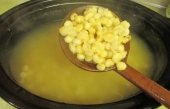





 3
3




Order copies of my book, Dairy Farming: The Beautiful Way at
www.createspace.com
Help spread the word! Thanks!
struggle - hustle - soul - desire










Order copies of my book, Dairy Farming: The Beautiful Way at
www.createspace.com
Help spread the word! Thanks!
struggle - hustle - soul - desire





Renate Haeckler wrote:... save the seeds to plant next spring.










Renate Haeckler wrote:If I'm growing corn from several ears bought at different locations, would that prevent inbreeding problems? And my thought is, for future generations, to have a rating scale of time of ripening, size of ears, disease-resistance, ease of removing kernels, and beauty, and keep more or fewer kernels from each ear to plant next year depending on how well they score, so I'm not just planting kernels from one ear.




The ultimate goal of farming is not the growing of crops, but the cultivation and perfection of human beings. - Masanobu Fukuoka




 1
1




The ultimate goal of farming is not the growing of crops, but the cultivation and perfection of human beings. - Masanobu Fukuoka








The ultimate goal of farming is not the growing of crops, but the cultivation and perfection of human beings. - Masanobu Fukuoka













The ultimate goal of farming is not the growing of crops, but the cultivation and perfection of human beings. - Masanobu Fukuoka





Jordan Lowery wrote:Beautiful, if your going to try grinding it for masa don't wash and rub all the pericap off, this is essential for a proper masa. I drain, fill with water and swish the bowl in a circle then drain, no rubbing. You may do this 2-3x.
Order copies of my book, Dairy Farming: The Beautiful Way at
www.createspace.com
Help spread the word! Thanks!
struggle - hustle - soul - desire
















The ultimate goal of farming is not the growing of crops, but the cultivation and perfection of human beings. - Masanobu Fukuoka




 2
2




Shenanigans of the sheep and wooly sort.. And many more.. https://www.instagram.com/girlwalkswithgoats/
Papa always says, "Don't go away angry... just go away."








Leila Rich wrote:
Off topic, but corn is apparently really susceptible to inbreeding depession and you need at least a couple of hundred plants to maintain strong genetics.
The seed should be fine next season, and probably much longer, but unless you're contiously adding seed with different genetics, seed saved from a small crop of corn will become quite pathetic quite quickly.
I've given up growing corn for various reasons, but being put off by the 200 plants thing is one!






David Williams wrote:The 200 plants number they refer to isn't on one plot, rather a "serviced pollen area"
If other people are growing relatives of corn/maize , fertilization will happen , building or destroying the gene pool





















The ultimate goal of farming is not the growing of crops, but the cultivation and perfection of human beings. - Masanobu Fukuoka








The ultimate goal of farming is not the growing of crops, but the cultivation and perfection of human beings. - Masanobu Fukuoka




 2
2









My project thread: http://www.permies.com/t/20399/projects/Maine-Master-Plan








Jessica Gorton wrote:Does anyone know if you can nixtamalize cornmeal after it has already been ground and stored? I make a lot of polenta for my family, and would like to incorporate the benefits of this process - via wood ash, since we have that in abundance.





|
Wow! It's so clean! Did you do this tiny ad?
Learn Permaculture through a little hard work
https://wheaton-labs.com/bootcamp
|







